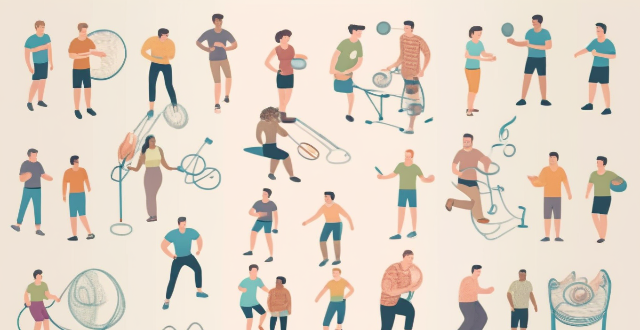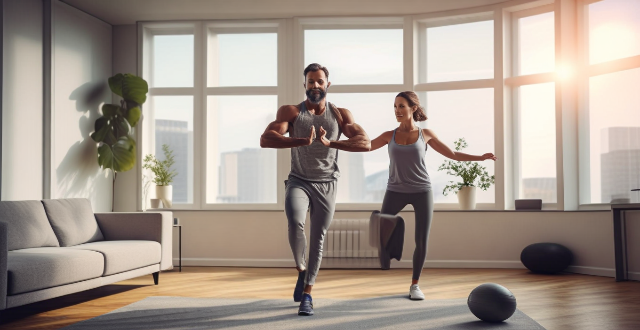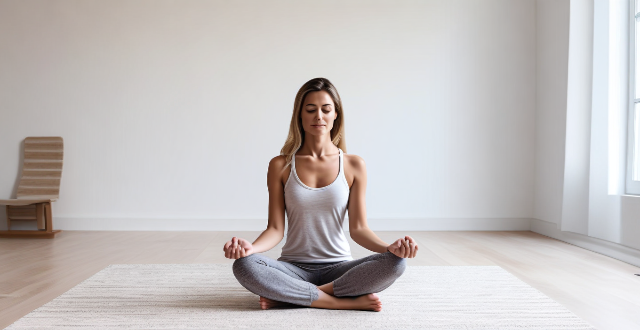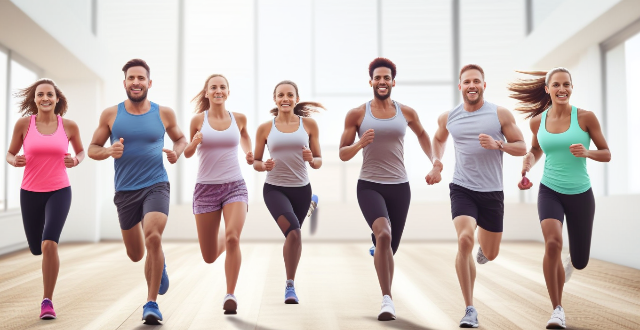Mindful Meditation

Can sport-specific meditation or mindfulness practices improve performance and mental clarity ?
Sport-specific meditation and mindfulness practices can improve performance and mental clarity for athletes. These techniques offer benefits such as improved focus, reduced stress and anxiety, and enhanced recovery. Incorporating these practices into training regimens can help athletes achieve better results.

How can I incorporate mindfulness into my daily routine to improve my personal health ?
Incorporating mindfulness into your daily routine can improve personal health by increasing self-awareness and reducing stress. Techniques include starting the day with meditation and gratitude, practicing mindful eating, single-tasking, taking nature breaks, walking meditation, breath awareness, mindful listening, tech-free time, body scans, positive affirmations, mindful movement, evening reflection, wind-down routines, bedtime meditation, sleep journaling, comfortable sleep environments, digital detox before bed, guided sleep meditations, and ending the day with a gratitude prayer.

Can meditation or mindfulness practices enhance sleep quality ?
Meditation and mindfulness practices have been gaining popularity for their potential benefits on mental and physical health, including improving sleep quality. These practices involve focusing one's attention on the present moment while calmly acknowledging and accepting one's feelings, thoughts, and bodily sensations. Meditation and mindfulness can enhance sleep quality by reducing stress and anxiety, promoting relaxation, and increasing awareness of sleep habits. To practice meditation or mindfulness for better sleep, individuals should set aside time each day, choose a comfortable environment, focus on their breath, cultivate gratitude and positive thinking, and be patient and persistent in their practice.

How does meditation help in improving concentration skills ?
Meditation helps improve concentration skills by strengthening neural connections in the prefrontal cortex, responsible for executive functions. Benefits include better attention span, working memory, mental clarity, multitasking, and reduced mind wandering. To start meditating, find a quiet space, set a time limit, use guided meditations, practice consistently, and stay open-minded.

How does meditation help in reducing exam stress ?
Meditation is a practice that has been used for centuries to promote relaxation, reduce stress, and improve overall well-being. When it comes to exam stress, meditation can be a powerful tool in helping students manage their anxiety and perform better. In this response, we will explore how meditation helps in reducing exam stress. The benefits of meditation include calming the mind, improving concentration, reducing physical symptoms of stress, and promoting better sleep. Regular meditation practice has been shown to improve concentration and attention span, which is particularly beneficial for students who need to focus on studying and retaining information for exams. By improving their ability to concentrate, they can study more efficiently and effectively. Meditation has also been found to reduce physical symptoms of stress such as headaches, muscle tension, and fatigue. By reducing these symptoms, students can feel more relaxed and better prepared for their exams. Additionally, meditation has been shown to promote better sleep by reducing stress levels and promoting relaxation. By getting enough restful sleep, students can wake up feeling refreshed and ready to tackle their exams. To practice meditation for exam stress reduction, find a quiet space where you won't be disturbed or distracted. Set a time limit for your meditation session and start with shorter sessions (5-10 minutes) before gradually increasing the duration. Focus on your breath and use guided meditation recordings or apps if you're new to meditation or struggling to focus. Practice regularly to experience the full benefits of meditation. In conclusion, meditation is a valuable tool for reducing exam stress and improving overall well-being. By calming the mind, improving concentration, reducing physical symptoms of stress, and promoting better sleep, meditation can help students feel more prepared and confident when facing their exams. Incorporating regular meditation practice into their routine can help students reap the benefits and approach their exams with a sense of calm and clarity.

Can yoga or meditation combined with exercise enhance emotion regulation ?
Emotion regulation is a crucial aspect of mental health, and it refers to the ability to manage and control one's emotional responses. There are various ways to enhance emotion regulation, and one of them is through physical activities such as yoga, meditation, and exercise. In this article, we will discuss how these practices can help improve emotion regulation. Yoga is a mind-body practice that combines physical postures, breathing techniques, and meditation. It has been shown to have numerous benefits for mental health, including enhancing emotion regulation. Yoga helps to reduce stress and anxiety, increases self-awareness, and promotes mindfulness. Meditation is another practice that involves focusing the mind on a particular object, thought, or activity to achieve a mentally clear and emotionally calm state. Like yoga, meditation has been shown to have numerous benefits for mental health, including enhancing emotion regulation. Meditation improves attention and focus, reduces emotional reactivity, and increases self-awareness. Exercise is another effective way to enhance emotion regulation. It reduces stress and anxiety, improves mood, and increases resilience. Combining yoga, meditation, and exercise can provide even greater benefits for emotion regulation by providing a comprehensive approach to well-being that addresses both the physical and mental aspects of emotion regulation.

How can mindfulness practices be integrated into sports psychology for improved focus and performance ?
Mindfulness practices can be integrated into sports psychology to improve focus and performance for athletes. Benefits include improved concentration, reduced anxiety and stress, enhanced self-awareness, and better recovery. Techniques such as breathing exercises, meditation, visualization, mindful movement, and journaling can be used by athletes to develop greater awareness of their thoughts, feelings, and surroundings. Incorporating these practices into training programs can help athletes stay calm under pressure, maintain focus during competitions, and improve overall performance.

Does exercise have a greater impact on mental health than meditation ?
Exercise and meditation are both beneficial for mental health, but it is difficult to determine which has a greater impact. Exercise can reduce stress and anxiety, improve self-esteem and cognitive function, and promote better sleep. Meditation can also reduce stress and anxiety, improve emotional regulation and self-awareness, and promote positive thinking. The effectiveness of each practice may vary depending on individual preferences and circumstances. It is important to choose a practice that suits your needs and engage in it regularly for optimal results.

How do athletes cope with the mental stress of competition ?
Athletes employ various strategies to cope with mental stress during competitions, including visualization and imagery, breathing techniques, goal setting, social support, mindfulness and meditation, professional help, and maintaining healthy lifestyle habits. These methods range from mental preparation techniques to seeking professional guidance and engaging in leisure activities for relaxation and enjoyment. By incorporating these strategies into their routines, athletes are better equipped to handle the psychological demands of competition.

How can I make healthier choices when eating out at restaurants ?
The text offers a comprehensive guide on how to make healthier choices when eating out at restaurants. It outlines strategies such as planning ahead, starting with a salad, controlling portion sizes, choosing cooking methods wisely, being mindful of sauces and condiments, drinking water, not fearing special requests, and practicing mindful eating. These tips aim to help individuals maintain a balanced and healthy lifestyle while still enjoying dining out experiences. The key takeaways are the importance of moderation, making informed choices, and listening to one's body to avoid overeating.

How does meditation help in reducing stress levels ?
Meditation is a practice that helps in reducing stress levels by calming the mind and body, improving concentration, promoting emotional health, increasing self-awareness, and enhancing mindfulness. It is a powerful tool for managing stress effectively and leading a happier, healthier life.

How does meditation or mindfulness practice contribute to creative development ?
Meditation and mindfulness practices can significantly foster creativity by enhancing attention, increasing awareness, reducing mental clutter, promoting emotional regulation, stimulating neurological growth, fostering a growth mindset, improving sleep quality, encouraging self-reflection, providing incubation time, and enhancing collaboration. Incorporating these practices into daily routines can help individuals unlock their full creative potential, leading to personal growth and innovation in various fields.

How can I train my brain to stay focused for longer periods of time ?
How can I train my brain to stay focused for longer periods of time? There are several ways to improve focus and concentration, including increasing physical activity, improving sleep quality, eating a healthy diet, practicing mindfulness meditation, and learning new skills or hobbies. Here are some tips for each: - Increase Physical Activity: Exercise releases endorphins that can help reduce stress and anxiety, as well as improve blood flow to the brain. Aim for at least 30 minutes per day, five days a week at a moderate intensity (70-85% of maximum heart rate). - Improve Sleep Quality: Getting enough sleep is crucial for maintaining good mental health and improving focus. Aim for 7-9 hours of quality sleep each night by practicing good sleep hygiene and using a sleep tracking app. - Eat a Healthy Diet: A healthy diet can provide the necessary nutrients for brain health, including whole foods like fruits, vegetables, lean proteins, and healthy fats. Avoid processed foods, sugary drinks, and saturated fats. - Practice Mindfulness Meditation: Mindfulness meditation can improve focus and reduce stress by teaching you to be present in the moment. Try practicing mindfulness for at least 10 minutes each day. - Learn New Skills or Hobbies: Learning new skills or hobbies can stimulate the brain and improve focus. Choose something that interests you and commit to learning it regularly. Set aside at least 30 minutes per day to practice.

Are there any particular exercises or stretches that promote better sleep ?
**Exercises and Stretches for Better Sleep** Sleep is crucial for overall health, and poor sleep can lead to various issues. Specific exercises and stretches can improve sleep quality. These include yoga poses like Child's Pose and Legs Up the Wall, meditation techniques such as Body Scan and Guided Meditation, gentle aerobic exercises like walking and swimming, stretching exercises including neck stretches and shoulder shrugs, and deep breathing exercises like the 4-7-8 technique and diaphragmatic breathing. Incorporating these into your routine can significantly improve your sleep quality.

Are there any specific types of exercises that are more effective for stress relief ?
There are several types of exercises that have been shown to be particularly effective for reducing stress and promoting relaxation, including aerobic exercise, yoga, tai chi, resistance training, and meditation. These activities can help to release endorphins, improve cardiovascular health, increase flexibility and strength, provide a sense of accomplishment, and quiet the mind, all of which can contribute to lower stress levels and improved mental well-being.

Can simple yoga help with stress relief and relaxation ?
Yoga, a practice that originated in ancient India, combines physical postures, breathing techniques, and meditation to promote overall well-being. Many people turn to yoga as a way to manage stress and find relaxation. Simple yoga can make a difference by providing both physical and mental benefits. Practicing yoga regularly can help improve flexibility and strength, better posture, increased energy, reduced stress and anxiety, improved focus and concentration, enhanced mood, better sleep, and mindfulness. To incorporate simple yoga into your routine, find a comfortable space, start with basic poses, focus on your breath, incorporate meditation, be consistent, and join a class or find online resources. By doing so, you can create a calming yoga routine that works for you and positively impacts your overall well-being.

How does yoga combine physical activity with mental relaxation ?
Yoga integrates physical activity and mental relaxation through various practices like asanas, pranayama, dhyana, and dharana. Asanas improve flexibility, strength, and endurance, while vinyasa increases heart rate for cardiovascular exercise. Pranayama techniques enhance lung capacity and stamina. Meditation calms the mind, and concentration practices sharpen focus. Yogic philosophy promotes emotional stability. Mindful movement connects physical practice with mental awareness, synchronized breath reduces strain, and restorative poses allow for deep relaxation. Overall, yoga offers a holistic approach to wellness by harmoniously blending body and mind.

What are some innovative approaches to incorporating physical activity into daily classroom routines ?
Incorporating physical activity into daily classroom routines is essential for student development. Brain breaks, movement stations, active learning games, outdoor experiences, and mindful moments are effective ways to promote physical health, cognitive abilities, social skills, and emotional well-being. Examples include stretching exercises, dance parties, yoga poses, math hoops, word cones, chair yoga, scavenger hunts, Jeopardy! relay races, spelling jump rope, nature walks, field trips, outdoor classrooms, breathing exercises, body scan meditations, and gratitude journaling.

How does yoga contribute to stress management ?
Yoga, a practice known for its relaxation benefits and overall well-being enhancement, significantly contributes to stress management. It regulates the nervous system, incorporates mindfulness and meditation, teaches breathing techniques, involves physical postures, improves sleep quality, provides social support, and encourages self-care. By practicing yoga regularly, individuals can effectively manage stress and promote mental health.

Can yoga help with weight loss ?
Yoga can be a valuable addition to a weight loss program due to its ability to improve muscle tone, increase flexibility, reduce stress levels, and promote mindful eating habits. Incorporating yoga into your routine along with other forms of exercise and healthy lifestyle habits can help you achieve your weight loss goals and improve overall health and well-being.

How do different religions view the importance of physical fitness and athleticism ?
This text explores the significance of physical fitness and athleticism in various religions, including Christianity, Islam, Hinduism, Buddhism, and Judaism. It highlights that while each religion has its unique perspective on maintaining a healthy body through exercise and sports, most acknowledge the importance of physical well-being for spiritual growth and fulfillment. The discussion emphasizes key points such as how Christians view the body as a temple, Muslims strive for balance in physical pursuits, Hindus see the body as a vehicle for enlightenment, Buddhists focus on gentle exercises, and Jews recognize the interconnectedness of physical and spiritual health. Overall, the text suggests that taking care of the body is essential across different faiths.

How do Hollywood stars maintain their fit physiques ?
Hollywood stars maintain their physiques through clean eating, regular workouts, restful sleep, and stress management. Personal trainers, nutritionists, and dermatologists provide professional guidance. Consistency and adaptability are key to long-term success.

How can I improve my personal health ?
Improving personal health involves a holistic approach that includes dietary habits, physical activity, mental well-being, and preventive care. Here's how to enhance your overall health: 1. **Dietary Habits**: Consume a balanced diet with fruits, vegetables, whole grains, lean proteins, and limited processed foods. Stay hydrated and practice mindful eating. 2. **Physical Activity**: Engage in regular exercise, including cardiovascular activities, strength training, and flexibility exercises. Adopt an active lifestyle by taking stairs and walking or biking short distances. 3. **Mental Well-being**: Manage stress through relaxation techniques, hobbies, and seeking professional help if needed. Ensure quality sleep and maintain positive thinking. 4. **Preventive Care**: Visit healthcare providers for regular check-ups and stay up to date with screenings and vaccinations. Make healthy lifestyle choices and be environmentally aware. Consistency is crucial, so start small and gradually build upon these practices to improve your personal health and well-being.

What role does mental preparation play in improving running performance ?
Mental preparation is key to improving running performance. It involves setting clear goals, using visualization techniques, practicing mindfulness exercises, and employing self-talk strategies. By training the mind to focus on the task at hand, manage stress, and maintain motivation, runners can enhance their physical performance and achieve their running goals.

How does an active lifestyle affect sleep quality ?
The text discusses how an active lifestyle can positively affect sleep quality. It outlines the benefits of physical activity for sleep, such as improved sleep onset, increased deep sleep, reduced sleep disturbances, enhanced REM sleep, and better sleep efficiency. The mechanisms underlying this relationship are also explored, including thermoregulation, stress reduction, neurotransmitter regulation, circadian rhythm alignment, and muscle relaxation. Practical tips for incorporating physical activity into one's routine are provided, such as choosing appropriate activities, establishing a routine, avoiding late-night workouts, being mindful of intensity, and incorporating relaxation techniques. Overall, the text emphasizes the importance of regular exercise for improving sleep quality and suggests ways to optimize its benefits.

Is it possible to lose weight without doing any exercise ?
Losing weight without exercise is a topic of interest for many individuals who want to shed pounds but may not have the time, ability, or desire to engage in physical activities. While exercise has numerous health benefits and can significantly aid in weight loss, it's not the only factor that influences your body weight. Here are several ways you might lose weight without traditional forms of exercise: - Dietary Changes: Eating a calorie-deficient diet, focusing on whole foods, practicing portion control, using smaller plates, limiting processed foods and sugars, and reading labels for serving sizes and calorie counts. - Lifestyle Changes: Increasing Non-Exercise Activity Thermogenesis (NEAT) by being more active in daily life, improving sleep habits by establishing a sleep routine, and managing stress levels through meditation, deep breathing exercises, and yoga. - Behavioral Changes: Keeping a food diary, setting realistic goals with small, sustainable changes, seeking professional advice from a registered dietitian or nutritionist, and creating personalized plans based on unique health profiles and preferences.

How can people with disabilities incorporate physical activity to improve their mental well-being ?
Physical activity is crucial for everyone's mental well-being, including those with disabilities. Engaging in physical activities can help reduce stress, anxiety, and depression while improving mood, self-esteem, and overall quality of life. Here are some ways people with disabilities can incorporate physical activity into their lives to improve their mental well-being: start slowly and gradually increase intensity; find an appropriate exercise routine; set realistic goals; incorporate mindfulness techniques; seek support from peers and professionals; make it fun!

How can I avoid impulse buying and stick to my budget ?
Impulse buying is a common problem for many people, but there are strategies you can use to avoid it and stick to your budget. Creating a budget, setting financial goals, using cash instead of credit cards, avoiding temptation, and practicing mindful spending are all effective ways to control your spending and achieve your financial objectives. By implementing these strategies, you can take control of your finances and make progress towards your long-term goals.

What constitutes proper cell phone etiquette for women in public ?
Proper cell phone etiquette is essential for women in public to maintain a professional and respectful image. Here are some guidelines to follow: - Keep your phone on silent or vibrate mode to avoid disturbing others and be considerate of the environment. - Use headphones or earbuds when listening to music or watching videos to respect personal space and avoid disturbing others. - Avoid talking loudly on your phone and step away from crowded areas if possible. - Be mindful of your surroundings and avoid using your phone during meetings or events. By following these guidelines, you can maintain a professional and respectful image while using your cell phone in public.